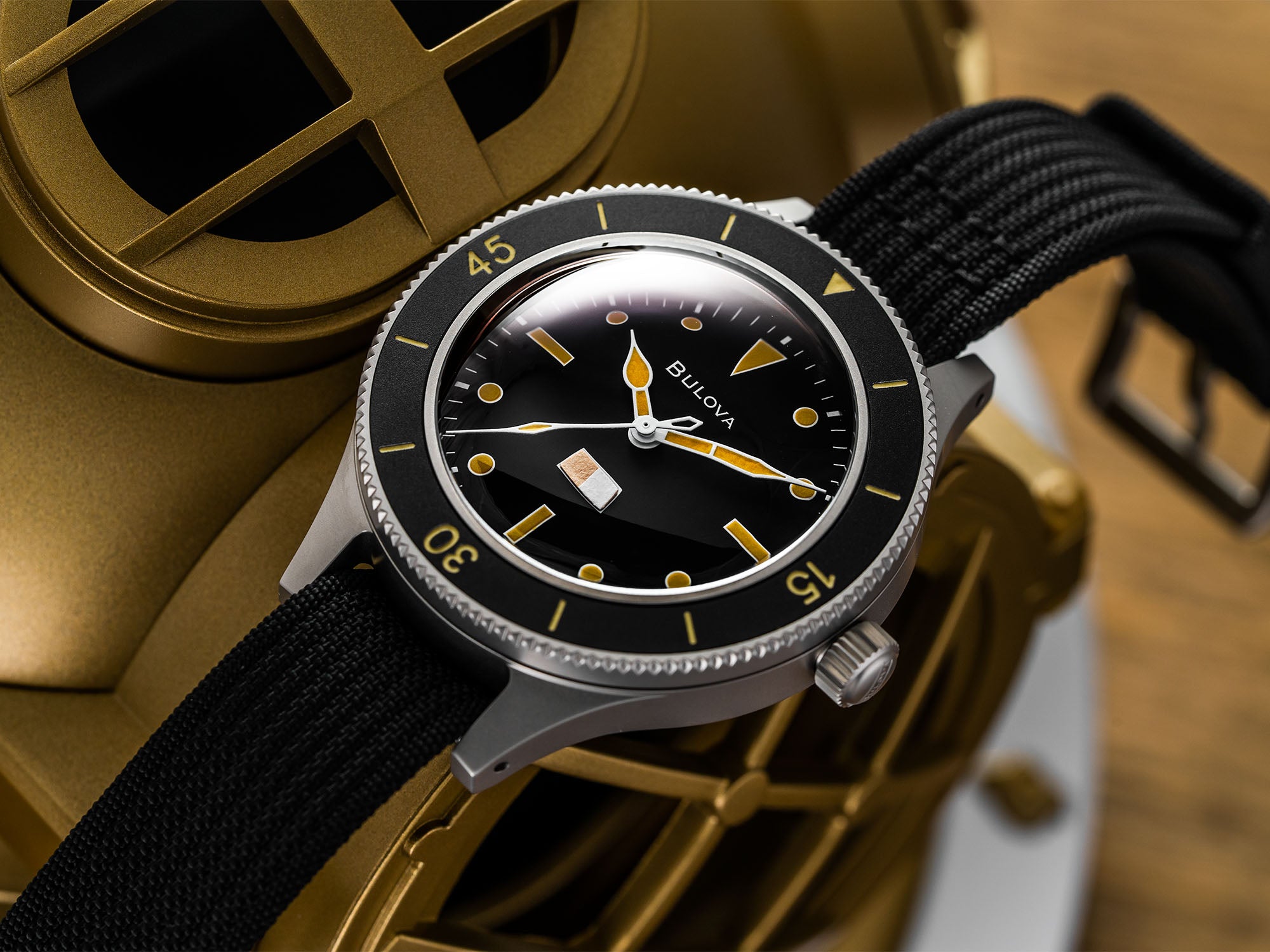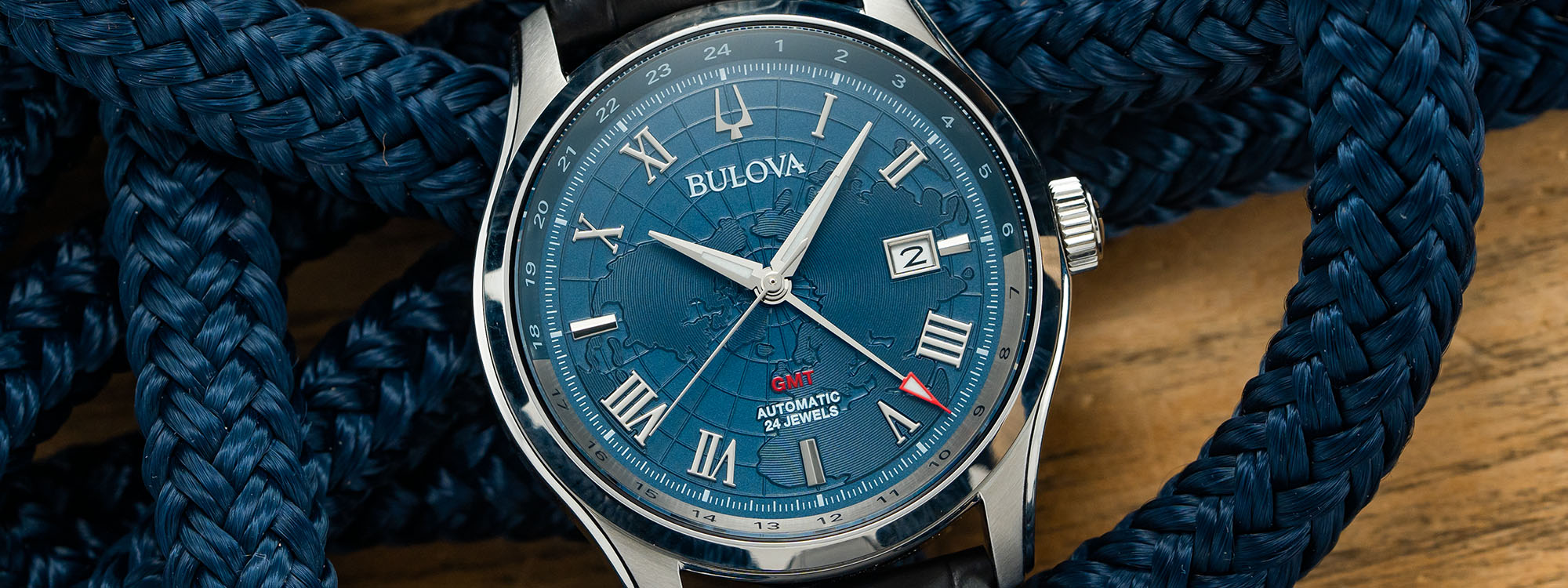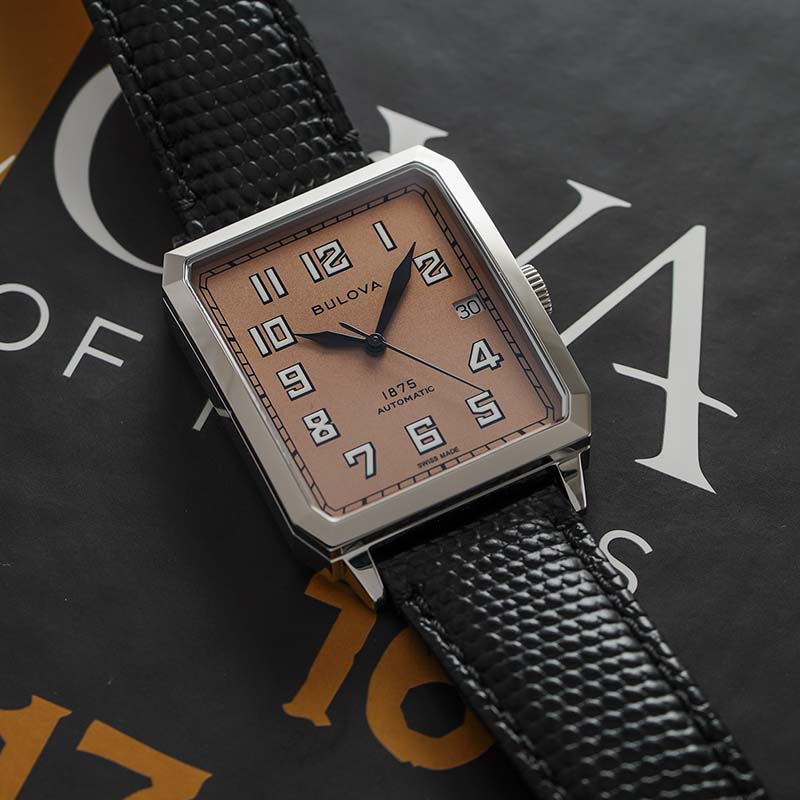Founded by Bohemian immigrant Joseph Bulova in 1875, originally with both its corporate headquarters and its manufacturing based in New York City, Bulova Watch Company is one of the most important historical watch brands in the United States. Many an American watch enthusiast has a story about the Bulova watch they inherited from a parent or grandparent, or about how their first watch was a Bulova before building up the financial wherewithal to delve into pricier Swiss luxury brands. Many of these enthusiasts may well be unaware of the many milestones that Bulova has contributed throughout its history — not just to American watchmaking to watchmaking in general — and how those milestones live on today in some of the brand’s most notable timepieces. Here we spotlight 10 important Bulova watches available now and the stories behind them; most are available in our online shop, many below MSRP.
A Watch That Helped Win Wars: Bulova Hack Watch

During World War II, Bulova took its patriotic duties as one of the few American-based watch companies quite seriously: many of its male employees joined the armed forces while female employees took over much of the watchmaking work at the factory. Bulova also devoted 25 percent of its advertising to the promotion of war bonds and stamps, a service for which it was awarded a distinguished service certificate by the U.S. government. Most notably, in the early 1940s, the company contracted with the United States government to produce instruments that would aid the war effort — altimeters, variometers, range-finding telescopes for artillery, time fuses for explosives, and (or course) wristwatches to be issued as official gear for American troops. The original Bulova “Hack” Watch got its name from its special feature, a lock-down mechanism for the running seconds that allowed for perfect synchronization, or hacking, of multiple watches in the planning of a mission. The modern version of the Hack Watch, part of Bulova’s historically inspired Military collection, features a vintage-look military-time dial with an inner 24-hour ring, large Arabic numerals, luminous cathedral hands, and a boxy crown. It’s powered by an automatic movement, a Japanese-made Miyota 8250, which has a 42-hour power reserve. Priced under $500, the Hack Watch is an undeniable value prospect for anyone looking for a watch with actual military pedigree.
A Watch That Went Into Space: Bulova Lunar Pilot

The Omega Speedmaster “Moonwatch” is the first watch that most of us think of when we think of the Space Race, but Bulova played a noteworthy role as well. In the 1960s and ’70s, the watchmaker was a frequent partner of NASA’s space programs, and personally gifted a one-of-a-kind, customized chronograph watch to Colonel Dave Scott, commander of the Apollo 15 mission, in 1971. Scott wore the timepiece, which had been specially engineered to withstand lunar conditions, as a backup after the crystal on his NASA-issued Speedmaster, according to records, had popped off. Scott’s Bulova watch — the only privately owned watch ever to visit the moon — sold at auction for $1.62 million in 2016. To commemorate the record-setting sale, and the historic space mission, Bulova released the Lunar Pilot Chronograph, a mostly faithful re-creation of the spacefaring original. which was equipped with a chronograph function to track the duration of oxygen supplies, battery power, and other life-sustaining onboard systems. The case —based on the original that was designed to withstand changes in pressure, temperatures, atmospheric conditions, and gravity — houses Bulova’s proprietary UHF (ultra high frequency) quartz caliber, beating at 262 Hz for an extremely high degree of timekeeping accuracy, losing just seconds per year, and a continuous sweep seconds hand for the stopwatch function, a rarity in quartz chronograph watches. Not a bad package for under $800.
The Watch of the Future Revisited: Accutron Spaceview

In 1960, Bulova made its most avant-garde and influential contribution to the science of watchmaking: the Bulova Accutron, the world’s first fully electronic watch. It incorporated a revolutionary new technology that utilized a 360-Hertz tuning fork, powered by an electronic oscillator, to drive the timekeeping functions rather than a traditional balance wheel. The Accutron’s groundbreaking movement, Caliber 214, achieved an oscillation rate of 360 times per second — nearly 150 times faster than that of a mechanical movement — and guaranteed an accuracy to just one minute per month. This unprecedented precision level, distinguished by the telltale humming of the tuning fork in place of the usual ticking, inspired the name Accutron, for “Accuracy through Electronic.” The Accutron was another Bulova invention that played a key role in the 1960s Space Race: Bulova installed Accutron dashboard clocks in all the spacecraft used in NASA’s Apollo missions. The model became a mainstay of the Bulova portfolio until it was finally spun off as an independent brand in 2020 (Both brands are now owned by Japan's Citizen Group, which acquired Bulova in 2007). The modern Accutron Spaceview watches (sans Bulova branding) features an innovative, proprietary movement powered by electrostatic energy generated from the motion of the wearer’s wrist. The movement’s fast-rotating twin turbines are affixed to two electrodes that power two tiny motors — one an electrostatic motor driving the seconds hand, the other a step motor for the hour and minute hands — both synchronized through integrated circuits for an accuracy of +/- 5 seconds per month.
An O.G. Dive Watch for the Modern Era: Bulova Devil Diver

In 1972, Bulova released a dive watch called the Oceanographer Snorkel, which built up something of a cult following in later years despite not making as much of a historical mark as iconic predecessors like the Blancpain Fifty Fathoms and Rolex Submariner. This was largely because of its affordable price in comparison to those watches as well as its nickname, “Devil Diver,” which referred to the 666-foot water resistance that Bulova proudly touted on its dial; most dive watches at the time topped out around 600 feet, or 200 meters. Bulova brought back the Devil Diver in 2018, basing it on the 1972 version, and expanded into other variations in subsequent years. The steel “turtle” case is a hefty and contemporary 44mm, with a 200-meter water resistance ensured by a screw-down crown. The dial, under a box-shaped sapphire crystal, hosts the original’s distinctive crosshairs motif, with wide rectangular hands and large dot indexes filled with Super-LumiNova. The Japanese-made, automatic Miyota 821D fuels the watch’s 42-hour power reserve, protected behind a solid caseback.
A Resurrected U.S. Navy Prototype: Bulova MIL-SHIPS

One of the rarest Bulova watch models, and another blast from the brand’s military past, resurfaced in 2021. In the late 1950s, Bulova made several prototype divers’ watches for the U.S. military that for various technical reasons never made it into serial production and were thus never actually worn by service members. (Long story short, Bulova focused its efforts on perfecting the Accutron rather than working the bugs out of its dive watch and the U.S. Navy ended up adopting the Blancpain Fifty Fathoms instead.) Bulova resurrected its prototype watch, under its original MIL-SHIPS codename, as part of its expanding vintage-inspired Military Collection. Its 41-mm sandblasted steel case is water resistant to 200 meters and houses an automatic caliber with a 41-hour power reserve. The vintage-look dial features cathedral hands, luminous hour markers, and a period-appropriate moisture indicator, a safety mechanism rarely found on dive watches today.
The Most Affordable Automatic Dual Timer: Bulova Wilton GMT
 Over its long history, Bulova has become well-known for offering mechanical complications at very accessible prices, and the timepiece that joined its Classic collection in 2022 is no exception. At just under $600 in our shop, the Wilton GMT is the rare example of a “true” GMT — i.e., one with an independently adjustable local hour hand — that just about any enthusiast can afford. The watch has a brushed steel case at 43mm; a dial in either white or blue, with applied Roman numerals matching the case tone, a date window at 3 o’clock, and a world-map textured pattern on its surface that adds to its value proposition. The central arrow-pointed GMT hand indicates a second time zone on the bicolor 24-hour scale on the dial’s flange. The Japanese Miyota movement inside is self-winding and stores a 42-hour power reserve.
Over its long history, Bulova has become well-known for offering mechanical complications at very accessible prices, and the timepiece that joined its Classic collection in 2022 is no exception. At just under $600 in our shop, the Wilton GMT is the rare example of a “true” GMT — i.e., one with an independently adjustable local hour hand — that just about any enthusiast can afford. The watch has a brushed steel case at 43mm; a dial in either white or blue, with applied Roman numerals matching the case tone, a date window at 3 o’clock, and a world-map textured pattern on its surface that adds to its value proposition. The central arrow-pointed GMT hand indicates a second time zone on the bicolor 24-hour scale on the dial’s flange. The Japanese Miyota movement inside is self-winding and stores a 42-hour power reserve.
Retro Rat Pack Elegance: Bulova Frank Sinatra Collection

Among Bulova’s many partnerships over the years are the strong ties it has forged with musicians and musical organizations and the creative collaborations that have resulted. Bulova has produced several special editions in cooperation with the Recording Academy, host of the annual Grammy Awards, and with multiple Grammy-winning artist Nile Rodgers, for example. The inspiration for the brand’s most recently introduced, musically inspired dress watch family goes all the way back to the 1950s and honors one of pop music’s icons. Bulova’s Frank Sinatra collection pays tribute to popular music’s legendary Chairman of the Board, who owned many Bulova watches throughout his life and counted Bulova as a sponsor of his Frank Sinatra Show on TV in the 1950s. The watches’ designs are inspired by Sinatra’s 1950s-1960s heyday, when smaller, thinner watches were in vogue, and take their names from some of Ol’ Blue Eyes’ most beloved hits. The Fly Me to the Moon model has a multi-part cushion-shaped case, alternating applied Arabic numerals and pyramid markers for the hours; sword-shaped hands, a 3 o’clock date window, and a reproduction of Frank’s signature at 6 o’clock, all set against a lyrical, radiating line motif from the center. The automatic Miyota movement is visible behind a clear caseback.
A Bicentennial Watch that Waves the Flag: Bulova Chronograph “C”

The 1970s were an era of funky colors and in-your-face, quirky style choices in the world of fashion; it was also the decade that the U.S. celebrated its 200th birthday and ushered in a brief pop-cultural flirtation with patriotic themes. Bulova’s Chronograph “C,” nicknamed “Stars and Stripes,” pays homage to both aspects of the Me Decade. The second model from Bulova’s historically influenced Archive series, after the Lunar Pilot, the watch is a modern re-edition of the original “Stars and Stripes,” which was discontinued just about a year after its debut in 1970 and whose very brief time on the market added to its collectibility. The “patriotic” theme of its red-white-and-blue tricompax dial represents for many a touchstone to the United States’ bicentennial year of 1976, even though the watch was long off the shelves by then. The modern version maintains the original’s flashy, primary-colors dial design, unusually shaped hands, and thick steel case with notched “coin edge” bezel — slightly larger than its ancestor at 46mm in diameter. Also like the 1970 model, the case is essentially lugless, integrating into a retro-cool steel mesh bracelet. Unlike the original model, which was powered by a mechanical Valjoux 7736, the contemporary watch contains a high-performance quartz chronograph movement, the same Bulova 262-kHz caliber found in the Lunar Pilot. A cover charge of $795 gets you the Chronograph “C” presented in a special box that includes both the mesh-metal bracelet and an additional navy-blue leather strap.
A Big Kahuna of a Chrono: Bulova Chronograph A “Surfboard”

Another short-lived, cult-classic Bulova chronograph was granted a second act as part of the Archive series in 2020. The original watch, nicknamed for the quirky, blue surfboard-shaped oval encompassing the two subdial counters at 3 and 9 o’clock, was produced for only two years, in 1970 and 1971. The modern versions are available in a handful of colorways and equipped with either a quartz chronograph caliber from Miyota or (in the initial limited edition) a Swiss-made automatic caliber from Sellita. Like the “Stars and Stripes,” the “Surfboard” is largely faithful to its ‘70s predecessor, with a tonneau case, pump-style chronograph pushers, and that funky bicolor dial with blocky rectangular hour and minute hands, red triangular seconds hand, and the two parallel, borderless subdials at 3 and 9 o’clock at opposite ends of the surfboard oval. The small, paddle-shaped hands on the subdials, along with the printed tachymeter scale on the edge, are also elements from the vintage watch. The brightly bicolored bezel is designed in a countdown style, with the final 20-minute sector in a contrasting color from the rest of the scale. Priced under $400 in the shop, the Chronograph A “Surfboard” will let you ride the big waves without "wiping out" your bank account.
A Chrono That’s Ahead of the Curve: Bulova Curv

Proving its longtime spirit of innovation was alive and well in the second decade of the 21st century, Bulova introduced what it called “the world’s first curved chronograph watch,” the simply named Bulova Curv, in 2016. The development of the watch required a bold engineering feat, basically starting with one of the brand’s proprietary ultra-high-frequency quartz Precisionist chronograph movements and carefully bending it to fit snugly into a slim case that was similarly curved for maximum ergonomic comfort on the wrist. The Bulova Curv is now an entire collection, comprising both sports and dress models, with prices starting around $750 and going up to about $1,200. As of 2020, Bulova offers models in which the case is both ergonomically curved and tonneau-shaped for an even bolder style statement. All Curv watches have a transparent caseback — a rarity for a watch with a quartz movement — that allows a view of the innovative curved mechanism inside, which boasts a frequency of 262 kilohertz, eight times greater than that of most quartz movements. The visual effect of this ultra-high frequency is evident on the dial: the central seconds hand doesn’t skip from second to second, as on a standard quartz watch, but moves in a continuous sweep around the dial, like that of a mechanical watch. As with the Accutron and other innovations, the Curv models clearly demonstrate Bulova's continuing devotion to making watch history.






















































1 Comment
I have a $800 Bulova and it’s nothing like what I’m seeing on here so why is it so expensive it’s the 300M